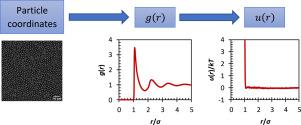将g(r)逆化为u(r):测试粒子插入法
Q3 Materials Science
引用次数: 0
摘要
将径向分布函数g(r)转化为对势u(r),可以通过多种方法实现。测试粒子插入最近成为一种求u(r)的有效逆方法。该方法可以同时分析模拟数据和实验数据,并且只需要输入粒子坐标的平衡快照。本文详细说明了该方法及其实现,并给出了示例代码。我们演示了测试粒子的数量和放置及其对效率的影响的复杂性,以及将该方法应用于实验数据的实用建议。这包括处理非周期边界条件的策略和代码、反演截止距离的选择和粒子粘附的影响。我们还讨论了该方法在高密度下的性能及其局限性。本文章由计算机程序翻译,如有差异,请以英文原文为准。

Inverting g(r) to u(r): The test-particle insertion method
Inverting the radial distribution function, , to a pair potential, , can be achieved by a variety of methods. Test-particle insertion has recently emerged as an efficient inverse method for finding . The method can analyse both simulated and experimental data, and the only input required is equilibrium snapshots of particle coordinates. This paper explains the method in detail and its implementation, sharing example code. We demonstrate intricacies in the number and placement of test particles and their effect on efficiency, as well as practical advice for applying the method to experimental data. This includes strategies and code for dealing with non-periodic boundary conditions, choice of inversion cutoff distance and the effect of particles sticking. We also discuss how the method performs at higher density and its limitations.
求助全文
通过发布文献求助,成功后即可免费获取论文全文。
去求助
来源期刊

JCIS open
Physical and Theoretical Chemistry, Colloid and Surface Chemistry, Surfaces, Coatings and Films
CiteScore
4.10
自引率
0.00%
发文量
0
审稿时长
36 days
 求助内容:
求助内容: 应助结果提醒方式:
应助结果提醒方式:


